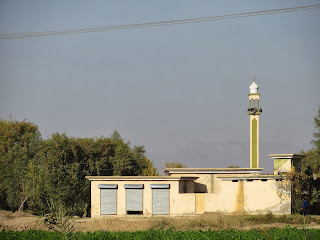Bannu District (ZILLA BANNU): Pashto: Urdu: ) BANNU is one of 24 districts that make up the Khyber Pakhtunkhwaprovince of Pakistan. It borders North Waziristan to the northwest, Karak to the northeast, Lakki Marwat to the southeast, and South Waziristan to the southwest. It is represented in the provincial assembly by four MPAs.[1]The district's main city is Bannu, near Waziristan.
The major industries of Bannu are cloth weaving and the manufacturing of cotton fabrics, machinery, and equipment. It is famous for its weekly Jumma fair. Although Bannu is surrounded by rugged and dry mountains, it is a very fertile place, and early English visitors had been known to refer to it as a "paradise".
Languages: Inhabitants of Bannu are known as Bannuchi and speak specific dialect of Pakhto Language. Saraiki dialect of Punjabi Language is also spoken by few. Urdu being National Language is also spoken and understood.
History: Bannuchi people trace their origins back to Arabia, coming from the Khost and Ghazni provinces of Afghanistan. Bannu was noted by the Sanskrit grammarian Pāṇini as the historical country of Varnu. The Chinese pilgrim Hsüan-tsang visited Bannu and Jaguda, Ghazni, while crossing the lands of O-po-kien (Afghans i.e. Pashtuns).
According to Avestan Vendidad, Varəna is one the 16 perfect lands created by Ahura Mazda and it is also associated with Bannu.[4]
The history of Bannu goes back many ages, due to its strategic location. Sheri Khan Tarakai is an ancient settlement site located in the Bannu District with ruins of the oldest known village settlement in the Bannu region, which was occupied from the late fifth until the early third millennium BC.
British Era:After the annexation of Punjab (then including the NWFP), the valley was administered by Herbert Edwardes. As a result of his administration, the region became a source of strong support during the Indian Rebellion of 1857. Although the valley itself was peaceful, it was subject to incursions from the Waziri tribes of theTochi Valley and the neighbouring hills. The primary export of the region was wheat. Salt and alum were also quarried at Kalabagh.
The modern district of Bannu was originally a tehsil of the old Bannu district of British India, in the Derajat Division of the North-West Frontier Province. The capital Bannu in the north-western corner of the district was the British base for expeditions to the Tochi Valley and the Waziristan frontier. A military road led from Bannu town toward Dera Ismail Khan.
Upon the creation of the North-West Frontier Province in 1901, the district of Bannu (equivalent to the now defunct Bannu Division), contained an area of 1,680 sq mi (4,351 km2) lying north of the Indus; the cis-Indus portions of Bannu were ceded to the Mianwali District of the Punjab.
In 1901 the District's population was 231,485, of whom the majority was Muslim. The principal tribes inhabiting the district are:
- Banizi, a Pashtun people who have always been very independent and stubbornly resisted the Sikh predecessors of the British.
- Wazir, comparatively recent immigrants from the hills, who are for the most part peaceable and good cultivators.
The Indus has no bridges within the district, but is navigable for local boats throughout its course of 76 mi (122 km). The main frontier tribes on the border are the Wazir, Bettani and Dawar
After independence
In 1990 Prime Minister Nawaz Sharif announced Bannu becoming a Divisional Headquarters. The Bannu District was divided in two, with the Lakki Marwat separating and becoming its own district.
Location
Bannu District is approximately 192 km (119 mi) south of Peshawar and lies within a sedimentary basin. It is flanked on all sides by the hard and dried mountain ranges of Koh-e-Safed and Koh-e-Suleiman. The Kurram River and its tributaries make it a scenic part of the southern region, with meadows, crops and orchards. Every kind of crop and fruit can be grown here, but its banana, date, fig and rice crops are especially unique in taste, smell and shape.
The Bannu District is located in the heart of the southern region, bordering the districts of Karak, Lakki Marwat and the North and South Waziristan agencies.
Economy
Bannu is of national economic importance, as it is the central market for the whole southern region. It also provides a safe and short route to the Central Asian markets.
Baran Dam, valuable for irrigation and the only dam in Pakistan,[citation needed] is situated in a natural low basin area and has never needed reconstruction since its initiation. Bannu has pure drinking water provided to all segments of society. The major industries of Bannu are cloth weaving and the manufacturing of cotton fabrics, machinery, and equipment.
Education
Since 1974 the people of Bannu had been continuously requesting that the federal and provincial governments establish a university. In 2005 the University of Science and Technology, Bannu was founded, after an announcement by Chief Minister Akram Khan Durrani of the Khyber Pakhtunkhwa, and an ordinance from the Governor. Other educational institutions include the Khyber Pakhtunkhwa University of Engineering and Technology (Bannu Campus), Bannu Medical College, VU (Islamic Institute of Education & Research) and the Danesh Kadda Bannu. Bannu is also home to two long-distance learning centres, BEST Institute Bannu (Sarhad University) and Danish Kadda, six degree colleges for girls and more than 500 primary, middle and higher secondary schools.
Demographics
The main tribes are BalochJats[6] the Bannuchi, Wazir, Awan, Mehsud, Dawar, Marwat and some Bangash and Hindus.[6] The district has a population of 677,346 spread over an area of 1,227 square kilometres (474 sq mi)
MANDAN AREA BANNU.
MANDAN PARK BANNU.
JAFFAR MASJID BANNU.
PARETY MASJID PARETY GATE BANNU.
ISMAIL KHANI AREA BANNU.








































No comments:
Post a Comment